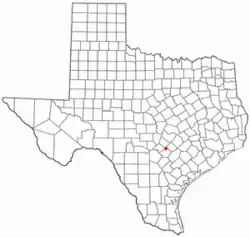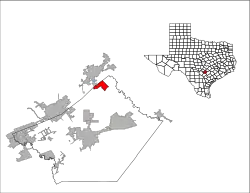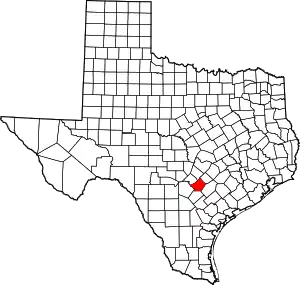Redwood, Texas | |
|---|---|
 Location of Redwood, Texas | |
 | |
| Coordinates: 29°48′53″N 97°54′48″W / 29.81472°N 97.91333°W | |
| Country | United States |
| State | Texas |
| County | Guadalupe |
| Area | |
| • Total | 6.5 sq mi (16.9 km2) |
| • Land | 6.4 sq mi (16.7 km2) |
| • Water | 0.08 sq mi (0.2 km2) |
| Elevation | 554 ft (169 m) |
| Population (2020) | |
| • Total | 4,003 |
| • Density | 673/sq mi (259.7/km2) |
| Time zone | UTC-6 (Central (CST)) |
| • Summer (DST) | UTC-5 (CDT) |
| ZIP code | 78666[1] |
| Area code(s) | 512 and 737 |
| FIPS code | 48-61352[2] |
| GNIS feature ID | 1366288[3] |
Redwood is an unincorporated community and census-designated place (CDP) in Guadalupe County, Texas, United States. The population was 4,003 at the 2020 census,[4] a decline from the figure of 4,338 tabulated in 2010. It is part of the San Antonio Metropolitan Statistical Area.
Geography
Redwood is located in the northeast corner of Guadalupe County at 29°48′53″N 97°54′48″W / 29.81472°N 97.91333°W (29.814750, -97.913375).[5] It is bordered to the north by Hays County and the city of San Marcos. Texas State Highway 123 forms the western border of Redwood; the highway leads north 5 miles (8 km) into San Marcos and south 16 miles (26 km) to Seguin, the Guadalupe County seat.
According to the United States Census Bureau, the Redwood CDP has a total area of 6.5 square miles (16.9 km2), of which 6.4 square miles (16.7 km2) are land and 0.1 square miles (0.2 km2), or 1.02%, are water.[4]
Demographics
| Race | Number | Percentage |
|---|---|---|
| White (NH) | 362 | 9.04% |
| Black or African American (NH) | 36 | 0.9% |
| Native American or Alaska Native (NH) | 1 | 0.02% |
| Asian (NH) | 20 | 0.5% |
| Some Other Race (NH) | 2 | 0.05% |
| Mixed/Multi-Racial (NH) | 46 | 1.15% |
| Hispanic or Latino | 3,536 | 88.33% |
| Total | 4,003 |
As of the 2020 United States census, there were 4,003 people, 1,026 households, and 733 families residing in the CDP.
As of the census[2] of 2000, there were 3,586 people, 901 households, and 785 families residing in the CDP. The population density was 610.6 inhabitants per square mile (235.8/km2). There were 946 housing units at an average density of 161.1 per square mile (62.2/km2). The racial makeup of the CDP was 48.13% White, 1.53% African American, 0.89% Native American, 0.11% Asian, 0.03% Pacific Islander, 44.73% from other races, and 4.57% from two or more races. Hispanic or Latino of any race were 84.16% of the population.
There were 901 households, out of which 58.7% had children under the age of 18 living with them, 63.9% were married couples living together, 13.4% had a female householder with no husband present, and 12.8% were non-families. 7.9% of all households were made up of individuals, and 2.1% had someone living alone who was 65 years of age or older. The average household size was 3.98 and the average family size was 4.16.
In the CDP, the population was spread out, with 39.1% under the age of 18, 11.2% from 18 to 24, 32.5% from 25 to 44, 14.2% from 45 to 64, and 2.9% who were 65 years of age or older. The median age was 25 years. For every 100 females, there were 110.4 males. For every 100 females age 18 and over, there were 107.3 males.
The median income for a household in the CDP was $30,132, and the median income for a family was $31,559. Males had a median income of $20,918 versus $14,816 for females. The per capita income for the CDP was $8,525. About 16.6% of families and 18.5% of the population were below the poverty line, including 20.9% of those under age 18 and none of those age 65 or over.
References
- ↑ "Redwood ZIP Code". zipdatamaps.com. 2023. Retrieved January 12, 2023.
- 1 2 "U.S. Census website". United States Census Bureau. Retrieved January 31, 2008.
- ↑ "US Board on Geographic Names". United States Geological Survey. October 25, 2007. Retrieved January 31, 2008.
- 1 2 "Geographic Identifiers: 2010 Demographic Profile Data (G001): Redwood CDP, Texas". U.S. Census Bureau, American Factfinder. Retrieved March 27, 2017.
- ↑ "US Gazetteer files: 2010, 2000, and 1990". United States Census Bureau. February 12, 2011. Retrieved April 23, 2011.
- ↑ "Explore Census Data". data.census.gov. Retrieved May 24, 2022.
- ↑ https://www.census.gov/
- ↑ "About the Hispanic Population and its Origin". www.census.gov. Retrieved May 18, 2022.
